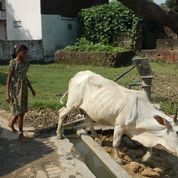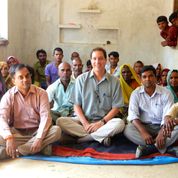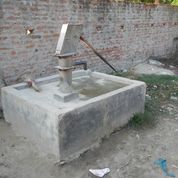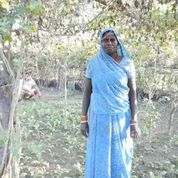
Sweating the Small Stuff: Indian Villages Plan for Climate Change
by Robert VerchickIn October, I wrote about the city of Surat, the diamond-polishing capital of India, and its battle against climate change. Recently I had the chance to visit another municipality working on adaptation, a place known more for its postage stamp farms and wandering livestock than jewelry and textiles. It’s called Gorakhpur, and is located in the flood-prone state of Uttar Pradesh, near the India-Nepal border.
 I first visited Gorakhpur nearly 25 years ago--when I was a long-haired backpacker and Gorakhpur was a muddy stop on the way to Kathmandu. Some things there haven’t changed. The streets are still muddy. Tea stalls and tarpaulin tents still line the streets, illuminated by the blue flames of cook stoves. At my business hotel, electricity was as unreliable as ever, and the telephones still crackled and hissed. Each morning, I would greet a dozen or so cows grazing on a hillock of garbage outside the hotel gate. (The city still has no regular solid waste collection).
I first visited Gorakhpur nearly 25 years ago--when I was a long-haired backpacker and Gorakhpur was a muddy stop on the way to Kathmandu. Some things there haven’t changed. The streets are still muddy. Tea stalls and tarpaulin tents still line the streets, illuminated by the blue flames of cook stoves. At my business hotel, electricity was as unreliable as ever, and the telephones still crackled and hissed. Each morning, I would greet a dozen or so cows grazing on a hillock of garbage outside the hotel gate. (The city still has no regular solid waste collection).
But Gorakhpur has also changed in important ways. The city has over four hundred thousand people, with millions more in the surrounding district. There are malls, cineplexes, fast-food joints, and pizzerias! What began as a small urban core has spread erratically, encroaching upon lakes, marshes, and scores of farm villages—all held together by a hectic flow of traffic and a mighty, tea-stained dome of hydrocarbons.
Like many communities in these arid plains, Gorakhpur suffers from flash floods in the rainy season which lead to “water logging,” a saturation of poorly drained soil that can ruin a season of farming. Faulty drainage channels and unmanaged garbage increase water logging as well as the related incidence of disease. Residents—who have always battled malaria and dysentery—are now seeing a rise in diarrhea, hepatitis, and Japanese encephalitis. These trends will increase as population and development grow. In addition, the rising temperatures and stronger rains associated with climate change will intensify these effects in dangerous but unpredictable ways.
 To learn more, I met with a long-time community organization called the Gorakhpur Environmental Action Group (GEAG) that is now helping farmers in the urban fringe to prepare for these growing risks. (GEAG released a preliminary report, “Toward a Resilient Gorakhpur,” in 2010.) Like the climate initiative in Surat, GEAG’s work is supported by the Asian Cities Climate Change Resilience Network (ACCCRN) and funded by the Rockefeller Foundation.
To learn more, I met with a long-time community organization called the Gorakhpur Environmental Action Group (GEAG) that is now helping farmers in the urban fringe to prepare for these growing risks. (GEAG released a preliminary report, “Toward a Resilient Gorakhpur,” in 2010.) Like the climate initiative in Surat, GEAG’s work is supported by the Asian Cities Climate Change Resilience Network (ACCCRN) and funded by the Rockefeller Foundation.
GEAG knows that Gorakhpur presents a spider’s web of institutional, environmental, and technical challenges, of which climate change is just a part. So the group wisely focuses on issues that, while related to climate, immediately and tangibly affect the lives of village residents. GEAG also emphasizes community activism and government accountability.
Accompanied by GEAG members Monojeet Ghoshal and Pragya Tiwari, I toured a couple of villages were progress is being made. I spoke with farmers about changes they have noticed in rain patterns and I saw an array of compact innovations designed to deliver high benefit at affordable cost. Residents here are learning to sweat the small stuff.
 For instance, stone-and-brick storm drains now line most pedestrian roads and alleys; and, unbelievably, nearly all appear to be functioning. New buildings are elevated and built to standards suggested by GEAG engineers. The hand pump at the neighborhood well had been reset on concrete steps many inches above the flood line to insure that drinking water is available even after harsh rains. Many vegetable farmers have begun growing two sets of crops—one on the ground, which is still prone to flood, and another on a frame of overhead “lofts” to support plants that grow on climbing vines. (One popular crop looked something like okra.)
For instance, stone-and-brick storm drains now line most pedestrian roads and alleys; and, unbelievably, nearly all appear to be functioning. New buildings are elevated and built to standards suggested by GEAG engineers. The hand pump at the neighborhood well had been reset on concrete steps many inches above the flood line to insure that drinking water is available even after harsh rains. Many vegetable farmers have begun growing two sets of crops—one on the ground, which is still prone to flood, and another on a frame of overhead “lofts” to support plants that grow on climbing vines. (One popular crop looked something like okra.)
But this is a story about much more than technology. Even the smallest changes to public space, from repaired drains to elevated pumps, require consistent pressure on the municipal government that too often avoids “village issues.” With the help of GEAG staffers, villagers I met had learned to organize efficiently, monitor their village infrastructure, and hold officials responsible. When plastic bags and other waste clogged their storm drains, the community appointed members to patrol the roads each week and record every instance of a blocked gutter or malfunctioning well; they would then deliver the information in a binder to the official in charge—repeatedly—until action was taken.
 To be sure, India needs big ideas too. Some, like environmentally sensitive irrigation techniques and improved seed varieties could yield large benefits. Others seem misguided. (Investors, for instance, have encouraged the Indian Parliament to open financial markets to weather derivatives, an idea I mentioned in an earlier post. Some economists believe derivatives trading could help village farmers hedge against poor harvests due to bad weather. But the financial and agricultural experts I’ve talked with in India are doubtful. Making good financial “bets” requires access to meteorological data and statistical skills that village farmers just don’t have, and such markets might invite corruption.)
To be sure, India needs big ideas too. Some, like environmentally sensitive irrigation techniques and improved seed varieties could yield large benefits. Others seem misguided. (Investors, for instance, have encouraged the Indian Parliament to open financial markets to weather derivatives, an idea I mentioned in an earlier post. Some economists believe derivatives trading could help village farmers hedge against poor harvests due to bad weather. But the financial and agricultural experts I’ve talked with in India are doubtful. Making good financial “bets” requires access to meteorological data and statistical skills that village farmers just don’t have, and such markets might invite corruption.)
But climate adaptation is coming to India—to rich cities like Surat and poor transitional cities like Gorakhpur. The key, as with many important ideas, will be sound implementation and improved governance.
© 2014 The Center for Progressive Reform